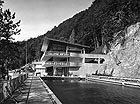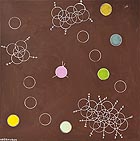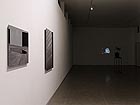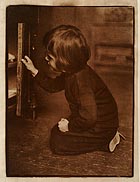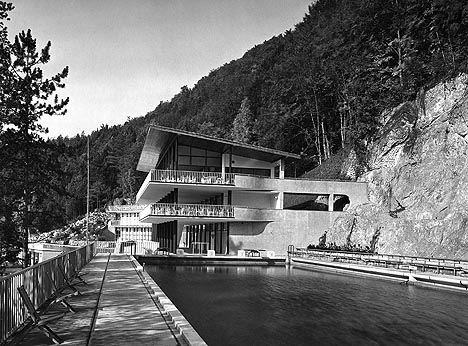
translated and summarized by: Liz Wollner-Grandville,
English summaries Janunary 10 - 24
Architektur im Ringturm, Wiener Städtische Allgemeine Versicherung AG
Bohuslav Fuchs
09.12.10 – 18.03.11
Expedition to the green frog
It is incomprehensible why Bohuslav Fuchs is still considered an insider tip in this country. As an architect he was part of the same crowd as Le Corbusier and others, but always remained in the background and unpretentious. The same can be said about his buildings that are characterized by an impressive stringency and rational elegance.
German-speaking literature on Functionalism and its main representative Fuchs already exists for quite some time. Even the city of Brno recognized that those who visited the city to see Ludwig Mies van der Rohe’s Villa Tugendhat were strongly inspired by Moravian architecture, of which there are numerous examples of unparalleled quality in Brno. Nevertheless, the search for great names, spectacular stories and traditional ideas still seems to shape the public perception of Brno and its architecture.
Thhe exhibition, which was curated by the expert on Functionalism in Brno, Jan Sapák, as well as the highly recommendable catalogue concentrate on Fuchs’s most representative buildings in Brno, Western Slovakia and the Moravian province. His oeuvre is presented in great detail, with plans and photographs of the meat market, the Café Zeman, the Hotel Avion, the Bank of Moravia, the Vesna School, the Masaryk dormitory, the public swimming pool, the Brno Werkbund housing estate, the Western Slovakian buildings of the 1930’s – primarily the Sanatorium Morava in the High Tatras and the unfortunately unused thermal spa Zelena Zaba (Green Frog). Maybe the increasing popularity of the architect will contribute to its reopening. With this in mind, let’s go to Trencianske Teplice!
By Iris Meder
Architektur im Ringturm, Wiener Städtische Allgemeine Versicherung AG
1010 Vienna, Schottenring 30
Tel: +43 1 531 39 Ext: 1115 or 1101
www.wienerstaedtische.at
Opening hours: Mon – Fri 9 a.m. – 6 p.m.
Galerie Altnöder
Oswald Oberhuber – I’m still around
13.01.11 – 26.02.11
I’m doing this, I’m doing that - anyhow and anyway
During the course of a lifetime it can be rather exhausting to incessantly reinvent oneself, position oneself anew, without finding oneself at some point, somewhere or to be found by others; without being stranded as the sum of a market-compatible life’s work of a single firmly rooted style.
Demanding, and presumably quite exhausting, A life without deference and with a false bottom can really take it out of you, even artistically. Unless one envisions a strategy of permanent change and pulls it through, like Oswald Oberhuber has always done.
In the exhibition commemorating his 80th birthday he proves himself for the umpteenth time as the master – not old master – of the unpredictable gesture, concerning the methods, makings, and machinations of contemporary art. There is nothing that appears shaken or bent by age, put in the backwater of pre-retirement or charity. “Very colorful, positive, unbelievable poetic, simply beautiful”, the artist describes the 18 new and novel paintings and a mini sculpture. So ignorant of history that one could easily ascribe them to a much younger artist, these pieces, which appear like the works by someone who was born much later, who should have grown up with the irrefutable certainties of a fundamental uncertainty, as the pupil of a libertine (liberal) availability and limited approachability. See the Internet and its consequences.
If it wouldn’t be for his at all times and omnipresent visible confidence with which he deals with forms, formats and formalities that the ever-curious master apprentice Oswald Oberhuber displays. In small format works, in which the experiment has established itself as an independent pictorial form, as a suggestion that the artist quickly discards of with stroke of a brush. Yet one should have a certain amount of ego to prove oneself in the incessantly pulsating and expanding art cosmos, including its black holes, as a planet rotating around its own axis, around which everything in turn rotates. Styles and their respective breaches for example. And as a parallel universe in which the most diverse genres of art (such as still lifes with their more or less colorful or melancholic hanging flowers, the mysterious visions of the world and the universe, numbers and time) form a playful entity. And this is all absolutely contemporary, as unholy as at the peak of time.
Addendum: a more than worthwhile addition and enhancement of the exhibition is offered by a compact mini-retrospective in the gallery’s collector’s cabinet. Selected pieces, starting with the early informal murals made in 1949, offer an (incomplete) overview of 50 (!) years of work. To be continued anytime: next year everything could be very, very different.
By Stephan Maier
Galerie Altnöder
5020 Salzburg, Sigmund-Haffner-Gasse 3
Tel.: +43 662 84 14 35
Fax: +43 662 84 14 35
Email: info@galerie-altnoeder.com
www.galerie-altnoeder.com
Opening hours: Tue – Thu 2.30 p.m. – 6 p.m
Galerie Stadtpark
Roman Fehr, Björn Kämmerer – Unstable Vacancy
11.12.10 – 19.02.11
Pictorial variation
In its annual winter exhibition, the Galerie Stadtpark presents two artistic positions that developed on the sidelines of the conventional art scene. “Unstable Vacancies” deals with vacancies, absences and so-called non-venues that are not only displayed on account of their poesy. Foremost, it is the artistic-structural analysis of the metaphorical that is presented, thereby opening the view for a media-theoretical reflection.
Roman Fehr, born 1974 in Vorarlberg, deals with two photographs showing distorted architecture. One depicts two dark driveways leading into a large building, of which only a section is visible. A grey area, which appears as if painted, forces itself between the two openings and its reflection can be seen in a large pool of water in front of the entrance. The second photo depicts a skyscraper whose silvery edge protrudes into the picture. Not in the least recognizable as a photograph, it could just as well pass as a painting. Fehr’s oeuvre enjoys playing with the painterly effect; they are based on photographs that he has transformed digitally by retouching them and taking out logos, doors or neon lights to achieve a planar and leveled overall effect. Thereby he creates poetic images with the artist’s influence remaining in the background. How close he gets to the Old Masters is shown in o.T. (tunnel) with its winter atmosphere reminding of Brueghel’s “Hunters in the snow”.
The German artist Björn Kämmerer, born 1977, presents a digitalized 27 -frame analogue 16mm film. It shows a feminine face that never really takes up eye contact with the viewer; instead, depending on the direction of the spotlight, it turns left or right. The protagonist attempts to escape the brightness, her irritation can actually be felt by the viewer. This effect was created by cutting and rearranging the 27 frames, illuminating the digital parts and thereby achieving a haptic feel. Kämmerer’s work offers an artistic control of perception to the narrative structure of a film.
All in all, an exhibition worth seeing, whose works create sensual moments despite their theoretical background. As good art should be.
By Susanne Rohringer
Galerie Stadtpark
3500 Krems, Wichnerstrasse
Tel.: +43 2732 847 05
Fax: +43 2732 812 76
Email: aeistatak@eunet.at
www.galeriestadtpark.at
Opening hours: Wed – Sat: 11 a.m. – 7 p.m.
Staatliche Kunstsammlungen Dresden
Art of Photography – Emancipation of a medium
04.12.10 – 07.03.11
„... and absolutely reaches the effect of a painting“ or how photography made it to the museum
In 1899, when Max Lehrs, the renowned graphic print expert and director of the Dresdner Kupferstich-Kabinett, described one of Karl Greger’s photos as „the dust cloud (above the herd of sheep heading homewards) is eminently perceived in an artistic way and reaches the effect of a painting.” (Max Lehrs, Dresdner Anzeiger, October 1899). He was reminded of the landscape paintings of the Worpswede Artist Community or the French Impressionists, Degas’ nude women or Böcklin’s cypresses. Photography was to find its way into the museums measured by the criteria of painting and not as an independent medium.
Photography – a new form of art or only a reproduction technique serving the purposes of science and art? At the end of the 19th century, Max Lehrs contributed decisively to the acceptance of photography as an artistic image media. The specialist for etchings was also a devotee of contemporary art: Koloman Moser, Emil Orlik, Max Klinger, Hans Thoma were welcome guests at his house and he supported them by buying their work. Lehrs’ devotion and his conviction that photography was “the natural continuation of the portrait collection (at the Kupferstich Kabinett), made the Dresdner collection to one of the first museums that displayed and acquired photographs – or received them as gifts. By 1914, more than 100 photographs by international amateurs and professional photographers were given to the museum as a gift as a result of Lehrs’ clever inquiries. In the 1910’s Lehr got involved in the development of photography and bought works by the Scottish pioneers David Octavius Hill and Robert Adamson, while in the 20’s his successor, Kurt Zoege von Manteuffel, focused on the Dresdner production. The exhibition “The Art of Photography. Emancipation of a medium” devotes itself to the early collections – and simultaneously leads to the history of reception of this genre in its attempt to find acceptance.
The first half of the exhibition refers to Max Lehrs’ first art photo exhibition in 1899. Lehr staged photography according to criteria more common to paintings; he arranged the presentation of 76 photographs in line with traditional topics such as portrait, landscape, atmospheric pictures, genre, animals, and “gum print masters”. The latter achieving the highest possible softness of contours – atmospherically loosened landscapes, portraits and experimented with the manipulation of the prints (e.g. the exhibition poster by Heinrich Kühn). Even today, to so-called Pictoralists are considered to be the founders of art photography in the late 19th century.
This is contrasted by the second part of the exhibition: photo art of the 1920 and 30s was an experimental field of “new vision”. Unusual perspectives, snapshots, multiple exposures, sharpness and clarity determined the aesthetics of the Dresdner photo studio. Kurt Zoege von Manteuffel, director of the Kupferstich Kabinett as of 1923, concentrated on dance photography and theater portraits. In the 1920s, photography gradually found acceptance as a medium of art. The “history of photography” at the Dresdner Kupferstich Kabinett is (re)constructed as the continuous development ranging from the fight for acceptance, the discovery of its own history, to the emancipation and development of a new form of expression.
By Alexandra Matzner
Staatliche Kunstsammlungen Dresden
01067 Dresden, Taschenberg 2
Tel: +49 (0) 351 49 14 2000
Fax: +49 (0) 351 49 14 2001
Email: info@skd-dresden.de
www.skd.museum
Opening hours: Mon –Fri: 8 a.m. – 6 p.m., Sat, Sun 10 a.m. – 6 p.m.
Mehr Texte von translated and summarized by: Liz Wollner-Grandville


 Teilen
Teilen

